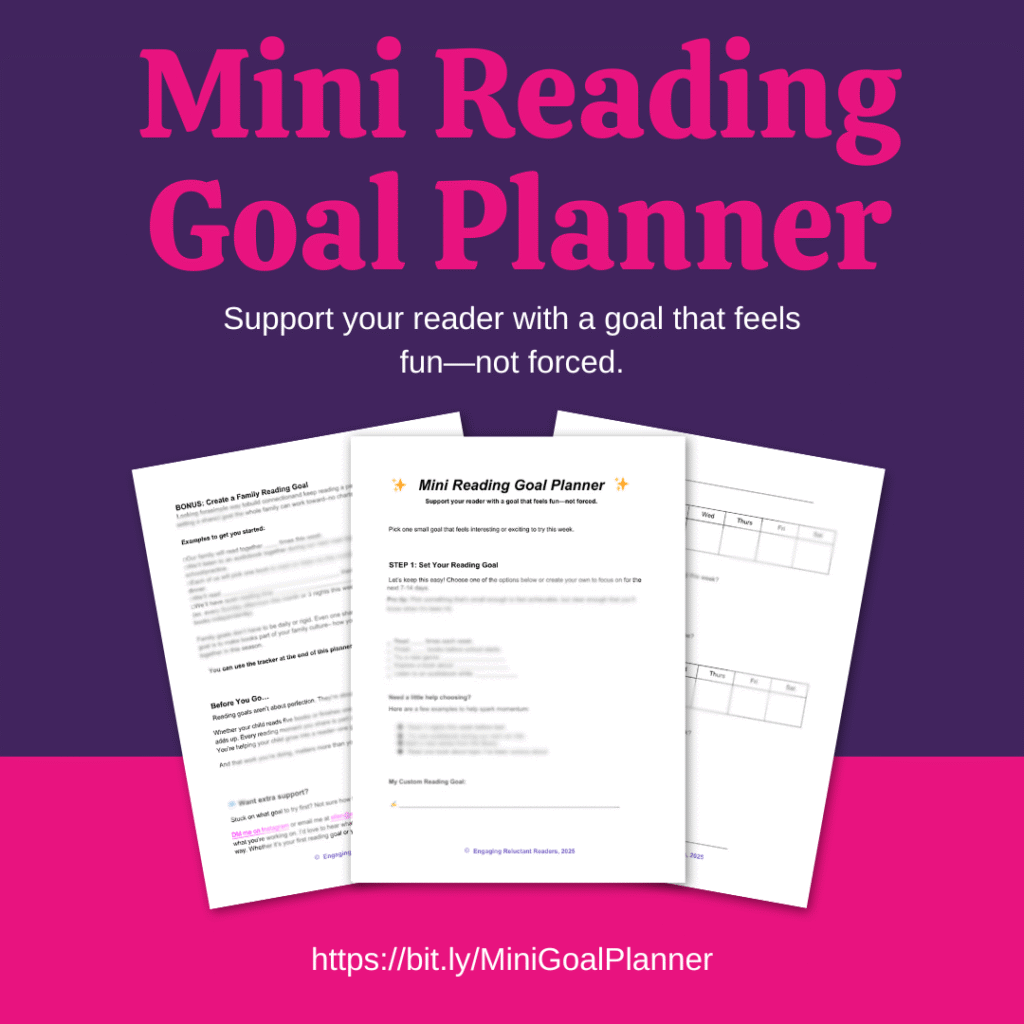How to Set a Reading Goal That Actually Sticks
🎧 Prefer to listen or 📺 watch instead?
This post is also available as a podcast episode and YouTube video.
Maybe you’ve just climbed out of a mid-summer reading slump. Maybe you’re still in it, or somewhere in that messy in-between. Either way, you’re here. You care. And that counts for more than you think.
You don’t need to overhaul your days or force a rigid plan. But sometimes, when reading has felt off-track for a while, a simple goal can be just enough to help you and your child find your rhythm again.
This post is the next step.
It’s for when your reading habits need a little direction—but not a total reboot. You’ll find ideas that are light, low-pressure, and flexible enough to shift with your energy (because let’s be honest: summer is long, and burnout is real).
Let’s talk about how to choose a reading goal that actually works—for your child, your family, and the season you’re in right now–especially if your reading rhythm feels a little off.

Why Reading Goals for Kids Work (Even When Motivation Is Low)
Let’s be honest—“goal” can feel like a loaded word. It might bring up visions of spreadsheets, timers, or library logs you never quite kept up with.
But a reading goal doesn’t have to be some big, long-term thing that takes weeks to reach.
It can be small. Flexible. Encouraging.
At its core, a reading goal is just a way to help your child feel a sense of direction—something simple they can move toward without turning reading into a pressure-filled task.
Here’s why it matters:
☑️ It sparks motivation. Seeing progress—like adding a bead to a jar or checking off a box—lights up the brain.
☑️ It builds confidence. When your child sets a goal and sees it through (even a tiny one), they start to believe, “I can do this.”
☑️ It creates momentum. One small win makes it easier to show up again tomorrow—without pushback or pressure.
This isn’t about reading more for the sake of it. It’s about helping your child reconnect with books in a way that feels like a yes, not a chore.

Forget the Page Counts–Shift the Way You Measure Progress
Reading five books doesn’t make someone a superstar. And reading the same book ten times doesn’t mean your child’s behind.
Summer brings dips in energy–for you and your kiddo. It’s normal for reading rhythms to slow down or shift. That doesn’t mean progress isn’t happening.
So instead of asking, “How many books have we finished?” try this:
How is reading feeling right now?
Progress isn’t always measured in pages. Sometimes, it’s found in the way your child shows up to read. So ask yourself:
- Are they grabbing books without being asked?
- Are they exploring new genres or authors?
- Have you noticed them showing more confidence or curiosity as they read?
And because every reader is different, what progress looks like—and how you support it—might look different too.
How to Monitor Progress (Specific to Your Unique Reader)
Some kids love a visual tracker. Others will ignore a sticker chart like it’s not even there.
Take my boys, for example.
JD lights up when there’s a checklist involved. He’s the kind of kid who adds things he’s already done just so he can cross them off. For him, a simple goal like “Read for 10 minutes a day” feels fun—especially if it means adding a bead to a jar or marking a box with his favorite pen.
Hunter, on the other hand, isn’t a fan of slow progress. Coloring in a tracker section by section or waiting to add stickers one at a time? That just doesn’t register for him. He’d rather have the satisfaction of coloring the whole image/tracker all at once or adding as many stickers as he wants to in a single sitting. But you know what he does love? A nightly read-aloud with me or my husband. Tracking isn’t really necessary for him as long as he gets that story and snuggle time he loves so much.

Because the point isn’t to make reading look a certain way. It’s to make reading feel like it fits.
That’s why the how matters just as much as the what. If tracking helps, great. If not? Let the reading itself be the win.
Let Kids Choose Their Reading Goals (and Why It Works)
One of the simplest ways to build buy-in? Let your child pick.
You can offer a few options—or brainstorm together—but giving them a say helps the goal feel like something they want, not something they have to do.
Here are a few light-touch ideas to start with:
🎧 Try an audiobook this weekend
📚 Start a new series before school starts
📖 Read together as a family three nights this week
And remember: a reading goal isn’t an ironclad contract. If they change their mind, hit a rough patch, or decide to tweak it halfway through? That’s okay. That’s actually part of the process.
Last week, Hunter decided he wanted to try a graphic novel for the first time and set a goal to finish it by the end of the week. It was a bold pick—especially since he knows I’m not likely to use graphic novels as a read-aloud option. That meant he’d either need to read it on his own or enlist JD’s help.
By midweek, it was clear things weren’t clicking. The text was a bit too tricky for him solo, and JD wasn’t in the mood to play narrator. So we pivoted—Hunter swapped the goal and chose to read three of the library books we’d picked out together instead.
In the end, we read two of them—and one we circled back to three times. On the last read-through, he read the whole thing himself. Extra reading, a real confidence boost, and the best part? No pushback.
You’re not trying to create a perfect plan—you’re helping your child discover what sticks.
4 Simple Steps to Set a Reading Goal That Sticks
Want to help your child choose a reading goal that sticks? Here’s a quick, flexible process you can walk through together—something that works for your real life, even when your energy is low.
1. Choose a Simple Target (That Sparks Reading Motivation)
Let your child pick one small goal:
- “Read three times this week.”
- “Try a new genre.”
- “Finish the book I started in June.”
You can offer a few options and let them choose—or brainstorm together. The key is keeping it small enough that it feels achievable, but clear enough to give them a sense of direction.
For example, “read tonight” or “read for 10 minutes” might feel manageable—but they’re not always specific or memorable enough to spark the momentum your reading rhythm needs.
2. Pick a Way to Track It (Without Pressure)
Match the method to their style:
- Stickers on a calendar
- Beads in a jar
- A whiteboard checklist
- An app like Bookly or Bookmory (Beanstack works if your child’s school or local library uses it for reading challenges).
If your child is like Hunter? Skip the formal tracker. Just keep a mental note, jot it on a sticky note, or track it quietly for yourself so you can circle back during your check-in. No need to force something that won’t feel motivating.

3. Decide When to Check In
Choose a time to check in together, once a week is plenty.
For longer goals, you might try a quick Sunday night chat:
- “How did reading go this week?”
- “What felt fun?”
- “What didn’t?”
For shorter-term goals (like reading three nights this week), check in after the final day.
The goal isn’t to audit their process–it’s to open up a judgment-free window into what’s working and what’s not so you can help them adjust, or celebrate what is.
4. Celebrate the Wins
Notice the small stuff out loud:
- “You stuck with it even when it got hard.”
- “You finished a book all on your own—how did that feel?”
- “Want to grab a new book at the library this week?”
And remember: the celebration doesn’t have to be big or expensive. Sometimes staying up a little later to read together—or getting 10 extra minutes to read solo before lights out (or after, with a flashlight!)—is all the motivation a kid really needs.
Family Reading Goals Made Simple
Remember: the goal here isn’t to “get ahead.” It’s to stay connected—to reading, to each other, and to a sense of progress that feels good.
Not sure where to begin? Try this:
Pick one goal to try this week. It could be:
- For your child
- For you
- For the whole family

Family goals are especially great when motivation is running low. Something like,
“Let’s read together three nights this week and see how it feels,” can gently bring everyone back into rhythm—without pressure.
Not into bedtime reading? Try one of these:
- “Let’s each pick a book for our road trip this weekend.” (Then make a point of pulling your book out first, when you’re not the one driving, as subtle encouragement).
- “Let’s listen to an audiobook together while we play or clean up the playroom.” (An audiobook can work great for a road trips too, especially if you’re the only driver.)
It doesn’t have to be perfect or even daily. What matters most is creating space to reconnect through stories–together.
Whatever the goal looks like, let it be light. Let it be shared. Let it be yours.
Reading Goal Progress Doesn’t Have to Look Perfect
You don’t need a color-coded plan or a perfectly tracked reading log. What you do need is one small step that feels like forward motion. Start with something simple—a shared story, a goal achieved, a spark of interest reignited.
That’s how progress builds. That’s how your child starts to see themselves as a reader—because they’re living it, not logging it.
So pick one goal. Make it feel realistic and right-sized for this season. And trust that even a little momentum can get things moving again.
Want Help Getting Started?
Grab the free Mini Reading Goal Planner—a simple, low-lift tool to help your child pick a goal that fits them, track their progress (if they want to), and celebrate the small wins that build momentum.
Whether you’re just coming out of a reading slump or looking to set a fresh rhythm, this quick-start guide is the perfect next step.

Resources to Support Simple Reading Goals
- Feeling stuck mid-summer? Start here: Mid-Summer Reading Slump? Try This Simple Reset
- Want a momentum booster? Try this: Why Book Series Work Like Magic for Reluctant Readers
- Curious how screen time can actually support reading? Read: How Movies Can Help Kids Fall in Love with Reading (Even Reluctant Ones)
- Looking for fun, low-lift reading ideas? Check out: 12 Easy Ways to Make Reading Fun Again
- Prefer to track reading digitally? Try apps like Bookly or Bookmory
- Thinking about audiobooks? Explore free options with Libby and Hoopla or try an Audible Free Trial
FAQs: Simple Reading Goals for Kids and Families
What’s a good summer reading goal for reluctant reader?
Keep it short, simple, and achievable. Instead of “read every day,” try “read three nights this week” or “finish one short book by the weekend.” The goal should feel like something your child can do—not something that adds pressure.
Should I use a reading log or tracker for my child?
Only if it helps them feel motivated. Some kids love tracking their progress with beads, stickers, or apps. Others ignore it completely. If your child finds it annoying or discouraging, skip it. You can always keep a mental note and check in casually once a week.
What should I do if my child doesn’t meet their reading goal?
Nothing dramatic. Goals aren’t contracts—they’re experiments. If it didn’t work, talk about why and try again with a tweak. Missed goals can be helpful info, not failure.
Are rewards okay for reading goals?
Yes—when they’re connected to the experience of reading. Things like staying up 10 minutes later to read, picking the next book, or choosing a cozy reading spot can make reading feel fun.
Need more help figuring out what motivates your child? Grab the free Motivating Reluctant Readers Guide for ideas that actually work—without bribery.
How can we set a reading goal as a family?
Start with something shared and low-key. Try “Let’s read together three nights this week” or “Let’s listen to an audiobook on our road trip.” Family goals can take the pressure off an individual child and turn reading into a connection point.
Do audiobooks or re-reads count toward reading goals?
Absolutely. So do comics, graphic novels, or even activity books. The goal is engagement—not checking a certain type of book off a list.



